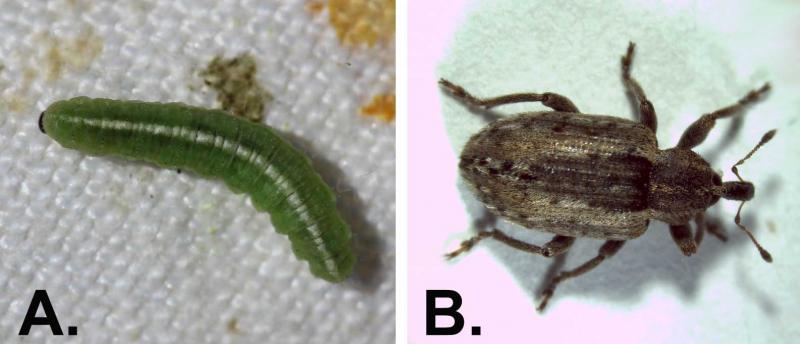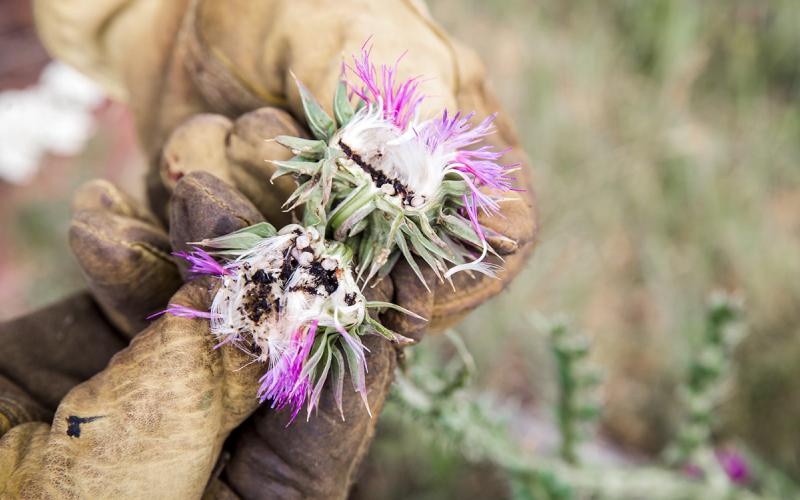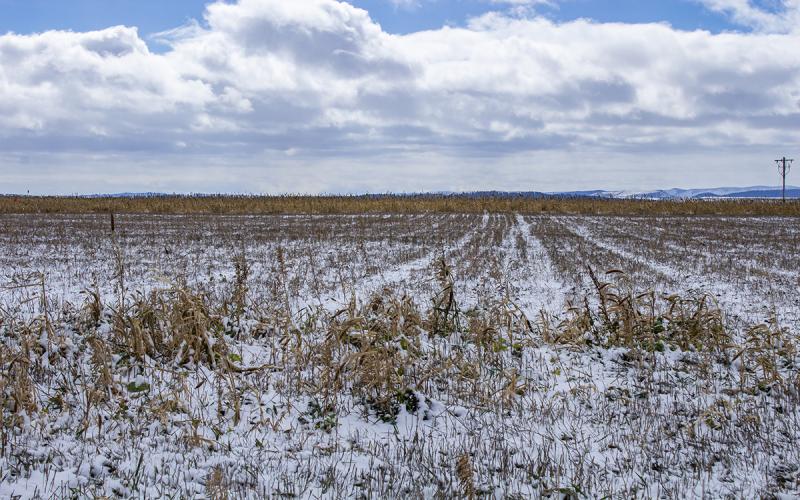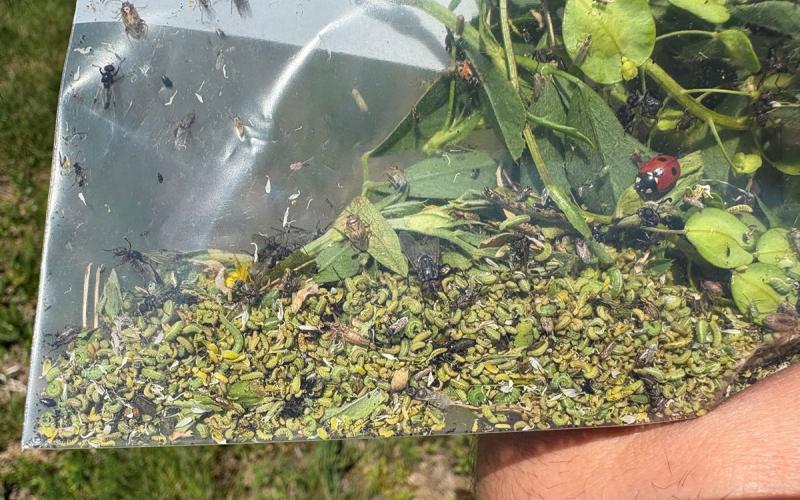The 2018 and 2019 alfalfa weevil populations were relatively low, and as a result, we didn’t receive very many calls regarding this pest during those years. However, 2020 has been quite a bit different, and alfalfa weevil populations seem to be much higher. In some areas of South Dakota, management has already occurred due to very high populations. Keep in mind that even after management, continued scouting of alfalfa is important to ensure that regrowth isn’t injured. During heavy infestations, alfalfa weevil adults and larvae both feed on the alfalfa plant. However, the larvae cause the greatest injury by feeding on the terminal buds of the plant, which can greatly affect alfalfa growth.
Identification

The larvae of the alfalfa weevil are small, green, and resemble caterpillars. They have a white stripe on their backs and a dark brown/black head capsule (Figure 1-A). The larvae will have 3-pairs of legs near their head.
The adults are small brown beetles with a darker brown stripe that runs down their midline. Alfalfa weevil adults also have an elongated snout that is characteristic of the weevil family. (Figure 1-B).
Scouting
The best way to determine if alfalfa weevils are present in a field is to use a sweep net and a five-gallon bucket. If you confirm alfalfa weevils are present in a field, the next step is to determine their population density. To do this, we recommend walking in a “Z” pattern and randomly sampling a total of 30 plants (i.e., sample approximately 10 plants per leg of the “Z”). Each plant that is selected needs to be pulled out gently and then hit against the inside of the five-gallon bucket to dislodge any larvae that are present. We recommend this method versus trying to count the beetles and larvae on the intact plant because adult alfalfa weevils will fall off the plant when disturbed as a defense mechanism.
Once completed, the plant should be measured to determine height and the number of larvae in the bucket should be counted. Repeat this process until a total of 30 plants have been sampled. Lastly, calculate the average number of larvae and the height of the plants. Tables 1-4 contain threshold information for alfalfa weevils based on plant height and the number of larvae present.
Economic Thresholds
|
|
||||
|---|---|---|---|---|
| $8 | $12 | $16 | $20 | |
| Value of hay per ton |
|
|||
| $60 | 84 | 127 | 169 | 211 |
| $80 | 63 | 95 | 127 | 158 |
| $100 | 51 | 76 | 101 | 127 |
| $120 | 42 | 63 | 84 | 105 |
| $140 | 36 | 54 | 72 | 90 |
| $160 | 32 | 47 | 63 | 79 |
| $180 | 28 | 42 | 56 | 70 |
| $200 | 25 | 38 | 51 | 63 |
| $220 | 23 | 35 | 46 | 58 |
|
|
||||
|---|---|---|---|---|
| $8 | $12 | $16 | $20 | |
| Value of hay per ton |
|
|||
| $60 | 91 | 137 | 183 | 225 |
| $80 | 68 | 102 | 136 | 171 |
| $100 | 54 | 81 | 95 | 137 |
| $120 | 45 | 68 | 91 | 114 |
| $140 | 39 | 59 | 77 | 99 |
| $160 | 34 | 51 | 68 | 86 |
| $180 | 30 | 45 | 60 | 77 |
| $200 | 27 | 41 | 54 | 69 |
| $220 | 25 | 37 | 49 | 63 |
|
|
||||
|---|---|---|---|---|
| $8 | $12 | $16 | $20 | |
| Value of hay per ton |
|
|||
| $60 | 99 | 149 | 199 | 240 |
| $80 | 75 | 113 | 150 | 186 |
| $100 | 62 | 90 | 120 | 149 |
| $120 | 50 | 75 | 100 | 124 |
| $140 | 43 | 64 | 86 | 107 |
| $160 | 37 | 56 | 75 | 93 |
| $180 | 32 | 50 | 67 | 84 |
| $200 | 29 | 45 | 60 | 76 |
| $220 | 26 | 41 | 55 | 69 |
|
|
||||
|---|---|---|---|---|
| $8 | $12 | $16 | $20 | |
| Value of hay per ton |
|
|||
| $60 | 104 | 156 | 182 | 260 |
| $80 | 78 | 117 | 137 | 195 |
| $100 | 63 | 94 | 110 | 156 |
| $120 | 52 | 78 | 105 | 130 |
| $140 | 45 | 67 | 90 | 112 |
| $160 | 39 | 58 | 79 | 98 |
| $180 | 35 | 52 | 70 | 87 |
| $200 | 31 | 47 | 63 | 79 |
| $220 | 28 | 42 | 57 | 72 |
Management
If thresholds are exceeded, there are several insecticides available for management. Please refer to the latest South Dakota Pest Management Guide - Alfalfa and Oilseeds for labeled insecticides and their associated rates. Neighboring states have received reports of pyrethroid failures when these insecticides were applied to manage alfalfa weevils. If you observe a pyrethroid failure please report it to Adam Varenhorst.


